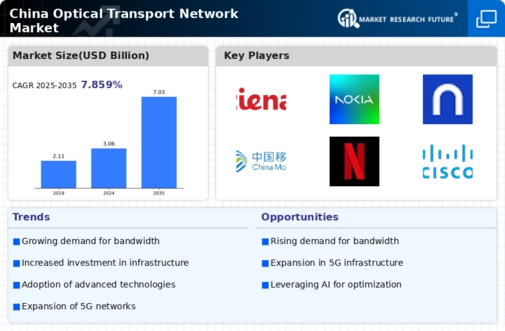Increasing Data Traffic
the market in China is experiencing a surge in data traffic, driven by the proliferation of digital services and applications. As more businesses and consumers rely on high-speed internet for activities such as streaming, online gaming, and cloud computing, the demand for robust optical transport solutions intensifies. Reports indicate that data traffic in China is expected to grow at a CAGR of approximately 30% over the next few years. This growth necessitates the deployment of advanced optical transport networks to ensure efficient data transmission and minimize latency. Consequently, service providers are investing heavily in upgrading their infrastructure to accommodate this increasing demand, thereby propelling the optical transport-network market forward.
Expansion of 5G Networks
The rollout of 5G networks across China is significantly influencing the optical transport-network market. With the anticipated increase in mobile data consumption and the need for ultra-reliable low-latency communication, optical transport networks are becoming essential for backhauling 5G traffic. The Chinese government has set ambitious targets for 5G deployment, aiming to cover major urban areas by 2025. This expansion is expected to drive investments in optical transport solutions, as they provide the necessary bandwidth and speed to support 5G applications. Analysts project that the optical transport-network market could see a growth rate of around 25% as a direct result of 5G infrastructure development, highlighting the critical role of optical technologies in this transition.
Focus on Network Security
In an era where cybersecurity threats are increasingly prevalent, the market in China is witnessing a heightened focus on network security. As organizations prioritize the protection of sensitive data, the demand for secure optical transport solutions is on the rise. Optical networks inherently offer advantages in terms of security, as they are less susceptible to interception compared to traditional copper networks. The Chinese government has implemented stringent regulations to enhance cybersecurity measures across various sectors, further driving the need for secure optical transport solutions. This emphasis on security is expected to contribute to the growth of the optical transport-network market, as businesses seek to invest in technologies that ensure the integrity and confidentiality of their data.
Rising Adoption of Cloud Services
The increasing adoption of cloud services in China is a pivotal driver for the optical transport-network market. As enterprises migrate their operations to the cloud, the demand for high-capacity, reliable connectivity solutions escalates. Optical transport networks are well-suited to meet these requirements, offering the necessary bandwidth and scalability. According to industry estimates, the cloud services market in China is projected to reach $100 billion by 2025, which will likely necessitate substantial investments in optical transport infrastructure. This trend indicates a growing reliance on optical technologies to facilitate seamless data transfer between cloud service providers and end-users, thereby enhancing the overall performance of the optical transport-network market.
Investment in Smart City Initiatives
China's commitment to developing smart cities is creating new opportunities for the optical transport-network market. As urban areas evolve into smart ecosystems, the demand for advanced communication networks becomes paramount. Optical transport networks are integral to supporting the vast array of IoT devices and applications that characterize smart cities. The Chinese government has allocated significant funding for smart city projects, with investments expected to exceed $300 billion by 2025. This influx of capital is likely to drive the adoption of optical transport solutions, as they provide the necessary infrastructure to support high-speed data transmission and connectivity across various smart city applications, thus fostering growth in the optical transport-network market.

















Leave a Comment